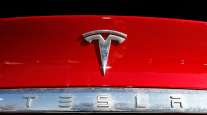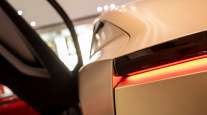Musk Says Tesla's New Autopilot Could Have Saved Driver

Elon Musk unveiled a new version of Tesla Motors Inc.’s Autopilot software on Sept. 11, saying its emphasis on radar over cameras to guide semi-autonomous cars might have saved the life of a driver in May.
Tesla has been under fire since Joshua Brown, a former Navy SEAL, was killed when his all-electric Tesla Model S sedan drove under a semi-trailer that was crossing a Florida highway. There’s no evidence that either Brown or the Autopilot system noticed the white side of the tractor-trailer against a bright sky, and the brakes were never applied.
RELATED: Elon Musk announces Tesla plan to build heavy trucks
The biggest change in Autopilot version 8.0 is a new starring role for radar, which since October 2014 has been used only to supplement camera sensors, Musk said in a blog post Sept. 11. The enhanced radar and a GPS database might have had a shot at saving Brown’s life, Musk said in response to a question on conference call with reporters.
“We believe it would have seen a large metal object across the road,” Musk said, referring to the tractor trailer. “Knowing that there is no overhead road sign there, it would have braked.”
Attorneys for the family of Brown, who lived in Ohio, couldn’t be reached for comment Sept. 11.
Palo Alto, California-based Tesla is upgrading the software, which automatically rolls out to customers over the airwaves, as it remains under scrutiny for the fatal May 7 crash. The U.S. National Highway Traffic Safety Administration opened an investigation into the accident, and safety advocates criticized Tesla for beta-testing autonomous-driving features with the public.
In another key development, the automatic-steering software has been designed to disengage if a driver ignores repeated warnings to keep hands safely on the steering wheel and to stay off until the driver parks the car, according to the blog.
“I am highly confident this will be a substantial improvement,” Musk told reporters.
Tesla said Autopilot version 8.0 now should recognize objects such as trucks crossing the road, piles of junk metal — even “a UFO” — and would know enough not to hit it, even if the system can’t decipher exactly what it’s seeing. Instead of supplementing the camera, radar alone “can be used as a primary control sensor,” according to the blog post.
The upgrade includes automatic feedback from the cars to GPS systems, to catalog fixed items that the radar sees — such as a sign over a highway — to prevent future false alarms for other drivers.
Though controversial, Tesla’s use of such so-called fleet learning is exciting and will allow the technology to progress much faster, said Bryant Walker Smith, a law professor at the University of South Carolina who has written extensively on driverless-car liability. Tesla’s growing fleet of autopilot-enabled cars — at least 90,000 — are driving about 1.5 million miles each day.
“Tesla is actually using its customers as trainers,” Smith said via e-mail Sept. 11. “These drivers will teach not only their own vehicle but also all of the other Tesla vehicles on the road to correctly recognize roadway objects.”
Autopilot accidents are far more likely to occur among drivers who have been using the technology for a while, Musk said. “It’s not the neophytes, it’s the experts,” he said. “They get very comfortable with it, and they repeatedly ignore the warnings."
With the latest update, the technology that Tesla calls Autosteer will hold drivers more accountable for keeping their hands on the steering wheel. After repeated warnings, if owners do not hold the steering wheel, the car will apply hazard lights, slow down and come to a stop. The Autosteer system can’t be re-engaged until the car has been parked.
The federal government is drafting guidelines, expected to be released this month, for automakers racing to bring fully self-driving cars to market.
While Ford Motor Co. and Alphabet Inc.’s Google espouse an all-or-nothing approach — saying that only fully autonomous cars are safe — Tesla has introduced driver-assist technology in “beta” form. Almost 1,000 Tesla customers are part of the company’s "early access program," which allows them to test new features and give feedback before they are rolled out to customers as a whole.
About 35,200 people were killed in U.S. auto accidents in 2015, according to NHTSA. The overwhelming majority of vehicle accidents — 94% — are due to human error. Safety regulators want to improve human behavior while promoting technology that will protect people in crashes and help prevent them from occurring.
Musk, in his defense of Autopilot, said Tesla vehicles have driven about 200 million cumulative miles with Autopilot engaged, and it would be “morally wrong” to withhold the technology. “It’s quite unequivocal that Autopilot improves safety,” he said. “And with this update, it improves it even more.”




